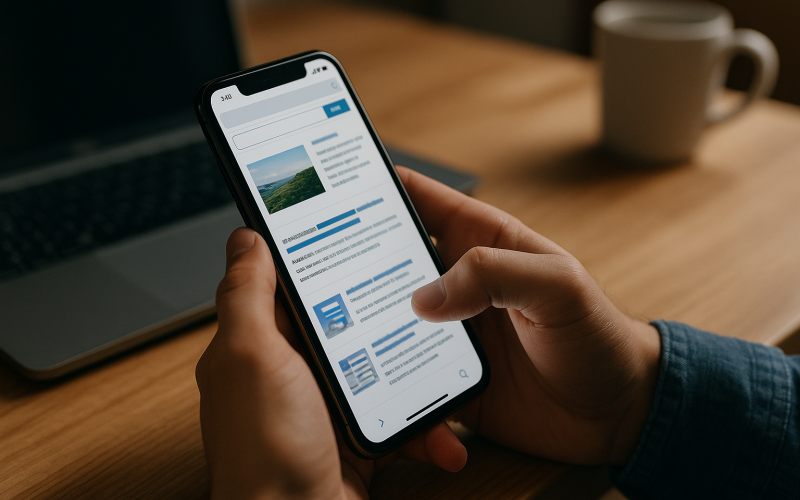Tailor Your Affiliate Marketing Website for Mobile Success

The mobile era is here to stay. With over half of all web traffic coming from smartphones and tablets, mobile optimization is no longer optional for affiliate marketers and online advertisers – it’s essential. If your promotional website isn’t tailored for mobile users, you’re likely missing out on traffic, conversions, and commissions.
Whether you’re a seasoned affiliate or just stepping into the world of monetized content, here’s how to effectively tailor your promotional site for mobile devices and maximize your online earnings.
1. Start with a Responsive Design
Responsive design ensures that your website automatically adjusts its layout based on the user’s screen size. Instead of creating separate desktop and mobile versions, a responsive site uses flexible grids and media queries to adapt content seamlessly.
- Choose a WordPress theme that’s mobile-responsive out of the box. Themes like Astra, GeneratePress, or Kadence are popular choices that offer speed and flexibility.
- Test your current site using Google’s PageSpeed Insights Mobile-Friendly Test to check for compatibility issues.
Why it matters: Google prioritizes mobile-friendly websites in its search rankings. Plus, users are more likely to stay (and click on your affiliate links) if the browsing experience feels smooth and intuitive.
2. Optimise Your Page Speed for Mobile Users
Mobile users expect fast loading times. If your page takes more than a few seconds to load, they’ll likely bounce – and you’ll lose a potential commission.
Tips to improve mobile speed:
- Compress images using tools like TinyPNG or ShortPixel.
- Use lazy loading to defer offscreen image rendering.
- Minimize JavaScript and CSS where possible.
- Enable caching with a plugin like WP Rocket or W3 Total Cache.
- Choose a lightweight, performance-optimized theme.
Pro tip: Check your performance using PageSpeed Insights and focus on the mobile tab for actionable improvements.
3. Create Click-Friendly Affiliate Links and Buttons
Fat fingers, small screens – you get the picture. On mobile, your affiliate links need to be easily tappable and visually prominent.
Best practices:
- Use large, bold buttons instead of hyperlinked text for your calls-to-action (CTAs).
- Leave plenty of spacing around buttons and links to prevent accidental clicks.
- Position important CTAs where users can easily reach them – especially the middle and bottom of the screen.
Example: Instead of a small “Check Price” link buried in text, try a large button that reads “See the Latest Price on Amazon” or “Get Instant Access.”
4. Simplify Navigation and Layout
Clutter kills conversions, especially on mobile. A clean, focused layout is key to helping users find what they’re looking for and click through your affiliate links.
Recommendations:
- Use a collapsible (hamburger) menu to streamline navigation.
- Stick to one or two clear goals per page; don’t overload your users with too many offers or distractions.
- Limit pop-ups and ensure any necessary ones are mobile-optimized and easy to close.
Bonus tip: Place the most relevant content at the top of the page so it’s visible without scrolling. Mobile users are often browsing quickly and may not reach the bottom.
5. Write Mobile-Optimized Content
Even the best design won’t save a page filled with dense paragraphs and tiny fonts. Write and format your content with mobile users in mind.
Here’s how:
- Use short paragraphs and bullet points to improve readability.
- Choose a legible font size (16px or larger is standard for body text).
- Add visual breaks like subheadings, dividers, and images to guide the reader.
- Keep headlines concise and compelling to hook mobile scrollers.
Example: Replace walls of text with “Top 3 Benefits,” “Quick Overview,” or “Who Should Use This?” sections for skimmable value.
6. Optimise for Voice Search and Local Intent
As voice searches and voice-based AI queries grow in popularity, especially on mobile, optimizing your site for conversational queries can give you an edge.
Strategies include:
- Use natural language and long-tail keywords in your content.
- Incorporate FAQs to match user questions.
- For local affiliate niches (like restaurants, gyms, or local tours), include geo-specific keywords and location-based content.
Why this helps: A user might say, “best wireless earbuds under $100” rather than typing “wireless earbuds cheap.” Structuring content around these phrases increases visibility.
7. Use Mobile-Specific Analytics to Track Performance
General site analytics are useful, but mobile-specific data gives you a sharper lens on what’s working and what needs improvement.
Look at:
- Mobile bounce rate versus desktop
- Heatmaps for mobile (using tools like Hotjar or Microsoft Clarity)
- Which affiliate links get tapped most on mobile
- Conversion rates broken down by device
Action tip: Set up event tracking for affiliate link clicks using Google Tag Manager or your analytics plugin to monitor what drives results.
8. Test Everything on Real Devices
Emulators and browser tools are helpful, but there’s no substitute for testing your site on actual phones and tablets.
Checklist:
- Try both iOS and Android devices
- Use different screen sizes (phones, phablets, tablets)
- Test your menus, buttons, and affiliate link placements
- Check loading speeds on mobile data vs Wi-Fi
Pro move: Ask friends or colleagues to give honest feedback on the mobile experience, especially if they’re in your target audience demographic.
9. Consider AMP (Accelerated Mobile Pages) – With Caution
AMP is a Google-backed project designed to create super-fast-loading mobile pages. While it can be helpful for content-heavy sites like blogs and news sites, it can sometimes strip down elements that are crucial for monetisation.
Pros:
- Lightning-fast load times
- Improved mobile SEO for some niches
Cons:
- Limited design and functionality
- Potentially reduced affiliate link tracking or styling
If you do use AMP, ensure it works well with your affiliate plugin or link cloaking tools like ThirstyAffiliates or Pretty Links.
10. Monetise with Mobile-Friendly Ad Networks
If you’re also earning through display advertising, make sure your ad placements aren’t ruining the user experience on mobile.
Tips:
- Choose responsive ad units (Google AdSense and Ezoic offer these).
- Avoid interstitials that cover the whole screen unless legally required (like cookie notices).
- Place ads between paragraphs or at the end of articles rather than disrupting the flow of content.
Remember, a poorly placed ad can cost you a conversion.
Final Thoughts: Mobile Optimization is a Revenue Multiplier
For affiliate marketers and content publishers, mobile isn’t just another channel – it’s the channel. Whether you’re linking to Amazon, promoting digital products, or running display ads, tailoring your site for smartphones can significantly improve your user experience, SEO, and ultimately, your earnings.
Stay updated, test continuously, and always design with the mobile user in mind. Because the easier it is for your visitors to navigate, read, and click, the more likely they are to convert.



